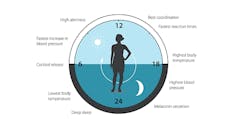Circadian scientists who have studied light's impact win Nobel
The award further validates the emerging field of human-centric lighting, which is helping to drive the LED industry's future.
For the second time in three years, a trio of scientists connected to lighting has won a Nobel Prize, as the Nobel Assembly has awarded three biologists with the Nobel Prize in Physiology or Medicine for helping to explain how the human circadian cycle works, including how light affects our daily rhythms.
Interested in articles & announcements on circadian light or human-centric lighting?
To be clear, light was not the centerpiece of research by the three new Nobel Laureates Jeffrey C. Hall, Michael Rosbash, and Michael W. Young — in contrast to the lighting centric work of Shuji Nakamura, Isamu Akasaki, and Hiroshi Amano who won the 2014 Nobel Prize in Physics for their invention of the blue LED.
Rather, Hall, Rosbash, and Young over the years revealed the complicated cell-level mechanisms that literally make the circadian clock tick, in work on fruit flies that has since been shown to also explain the circadian processes in humans. Hall is affiliated with Rockefeller University in New York, and Rosbash and Young with Brandeis University in Boston, as well as the University of Maine for Young.
In investigations spanning a decade or more starting in 1984, they identified three genes, including the “period gene” that helps build a protein called PER, which accumulates in a cell's nucleus. PER also blocks the period gene from making more PER and then degrades during the day. Another gene called “timeless” assists the process by helping to build a protein called TIM that moves PER from one part of the cell into the nucleus, where it needs to be. A third gene called “doubletime” helps build a protein called DBT that delays PER's accumulation.
Together, those genes keep the circadian clock in sync, which is crucial because the clock regulates critical functions such as behavior, hormone levels, sleep, body temperature, blood pressure, and metabolism.
Messing with the clock could throw off any of those functions, which has ramifications for health and wellbeing, and has been linked in other research to diseases including cancer, diabetes, and more.
Light is one factor that can throw the clock out of rhythm, a fact not lost on the three new Nobel Laureates Hall, Rosbash, and Young.
“The paradigm-shifting discoveries by the Laureates established key mechanistic principles for the biological clock,” the Nobel Foundation said in announcing the prize. “During the following years, other molecular components of the clockwork mechanism were elucidated, explaining its stability and function. For example, this year’s Laureates identified additional proteins required for the activation of the period gene, as well as for the mechanism by which light can synchronize the clock.”
And in a more in-depth summary of the trio's work, professor of neuroscience Carlos Ibañez from the Nobel Assembly, which awarded the prize, noted that “the building blocks of a circadian system consist of a self-sustained 24-hour rhythm generator or oscillator, setting or entraining mechanisms that link the internal oscillator to external stimuli (referred to as zeitgebers, i.e., timekeepers), such as light, and output mechanisms to allow the timely scheduling of physiological processes.”
Ibañez further noted that at one point the Laureates’ efforts probed whether “light-sensitive channels” are involved in the dissipation of PER.
He also noted that Hall and Rosbash co-authored a 1998 paper with others, looking at how the CRY gene and its related cryptochrome proteins work as photoreceptors for blue light that help reset the circadian rhythm.
Ibañez concludes, “The discovery of self-sustained transcription/translation feedback loops as the central component of the molecular mechanism by which clock genes control circadian oscillations in cells and tissues has led to a new paradigm in our understanding of how organisms anticipate and adapt to the regular daily environmental cues such as light. Since the seminal discoveries by the three Laureates, elucidating a fundamental physiological mechanism, circadian biology has developed into a vast and highly dynamic research field, with important implications for our health and wellbeing.”
Certainly, there is now plenty of research looking into light's role — including that of artificial LED light — as both villain and hero in circadian health. And LED lighting vendors are in the early days of selling so-called human-centric lighting (HCL) systems, also known as circadian lighting. LEDs Magazine has reported on many developments, and will soon publish a two-part feature examining HCL in the workplace. That series follows last year's two-part report, when we looked at early successes of HCL in healthcare and in the office.
The Nobel Prize in Physiology or Medicine is awarded by the Nobel Assembly at Karolinska Institute in Stockholm. Karolinska Institute is a medical university. You can read their announcement of the 2017 award here, and the more in-depth account by Ibañez here. The Nobel Prize in Physics, won by Nakamura and his cohorts in 2014, is awarded by the Royal Swedish Academy of Sciences.
Want to read more about human-centric lighting? Try these:
How LEDs are eliminating mistakes in the operating room
Forget coffee. Blue LED light will stimulate drivers
Helvar adds software for human-centric lighting
Human-centric lighting reduces drug reliance at Danish psychiatric hospital
European lighting regulations could help usher in human-centric lighting
Pact puts circadian lighting on the buying list for thousands of US healthcare providers
MARK HALPERis a contributing editor for LEDs Magazine, and an energy, technology, and business journalist ([email protected]).

Mark Halper | Contributing Editor, LEDs Magazine, and Business/Energy/Technology Journalist
Mark Halper is a freelance business, technology, and science journalist who covers everything from media moguls to subatomic particles. Halper has written from locations around the world for TIME Magazine, Fortune, Forbes, the New York Times, the Financial Times, the Guardian, CBS, Wired, and many others. A US citizen living in Britain, he cut his journalism teeth cutting and pasting copy for an English-language daily newspaper in Mexico City. Halper has a BA in history from Cornell University.





